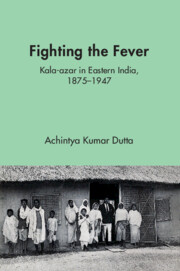Book contents
- Frontmatter
- Dedication
- Contents
- List of Figures
- List of Maps
- List of Tables
- Preface and Acknowledgements
- Note on Permissions
- List of Abbreviations
- Introduction
- 1 Kala-azar: A Disease Sui Generis
- 2 Medical Intervention and Containment of Epidemics
- 3 Agony of Assam: Defeating the Dreadful Kala-azar
- 4 Bengal’s Black Fever Burden: Beating the Disease
- 5 ‘Black Sigh’ in Bihar: Experiences and Responses
- 6 From Tartar Emetic to Urea Stibamine: Medical Research on Kala-azar and Its Fruition
- 7 The Unsung Hero: The Genius of Upendra Nath Brahmachari
- Conclusion
- Appendix: Number of Kala-azar Patients Admitted for Treatment in Bengal
- Bibliography
- Index
3 - Agony of Assam: Defeating the Dreadful Kala-azar
Published online by Cambridge University Press: 13 February 2025
- Frontmatter
- Dedication
- Contents
- List of Figures
- List of Maps
- List of Tables
- Preface and Acknowledgements
- Note on Permissions
- List of Abbreviations
- Introduction
- 1 Kala-azar: A Disease Sui Generis
- 2 Medical Intervention and Containment of Epidemics
- 3 Agony of Assam: Defeating the Dreadful Kala-azar
- 4 Bengal’s Black Fever Burden: Beating the Disease
- 5 ‘Black Sigh’ in Bihar: Experiences and Responses
- 6 From Tartar Emetic to Urea Stibamine: Medical Research on Kala-azar and Its Fruition
- 7 The Unsung Hero: The Genius of Upendra Nath Brahmachari
- Conclusion
- Appendix: Number of Kala-azar Patients Admitted for Treatment in Bengal
- Bibliography
- Index
Summary
[T]he people of the affected districts are in such terror of the disease, that they have even broken through their social and religious customs in their endeavours to escape the infection.
By 1891 the disease had travelled eastwards and firmly established itself in Nowgong district and all the intervening territory, and from this year until 1901 there raged, especially in the Nowgong area, the terrible epidemic which has made the ‘kala-azar’ words of terror in Assam…. Whole villages were wiped out, or deserted by the few survivors, and the land on which they stood reverted to jungle.
No other Indian province suffered as severely as Assam did from visceral leishmaniasis, often known as kala-azar. During the colonial era, it wreaked havoc in Assam, destroying nearly every aspect of society and leaving the victims in destitution of an unseen level. The colonial administration took action to control it as soon as it started spreading as an epidemic, and these controls persisted until the end of colonial authority. However, it was unable to provide the anticipated results, and the illness persisted, continuing to pose a major threat to the Assamese population. This chapter attempts to explain the causes, mechanisms, and outcomes of the disease's Brahmaputra-wide spread. The effectiveness of British medical policy and contemporary medicine in halting its advancement is examined in that setting. The chapter also examines how the populace viewed the illness and how they reacted to government anti-kala-azar initiatives. In this context, a short account of the condition of Assam's people and the health scenario of the province as a whole would help understand the context of the outbreak of kala-azar and its perilous effects.
A Brief History of Assam: The Condition of the People and the Outbreak of Disease
Situated on the northeastern part of the British Empire in India and bordering the powerful neighbouring states of China, Burma, and Bhutan, Assam was the most important British possession in this region. The extraordinary fertility of the region, with its vast lowlands and agricultural productivity, made it very attractive to its people and even outsiders. Before the Burmese occupation in the early nineteenth century, Assam was under the Ahom rule (1228–1818) and was, on the whole, prosperous.
- Type
- Chapter
- Information
- Fighting the FeverKala-azar in Eastern India, 1870s–1940s, pp. 127 - 181Publisher: Cambridge University PressPrint publication year: 2025

